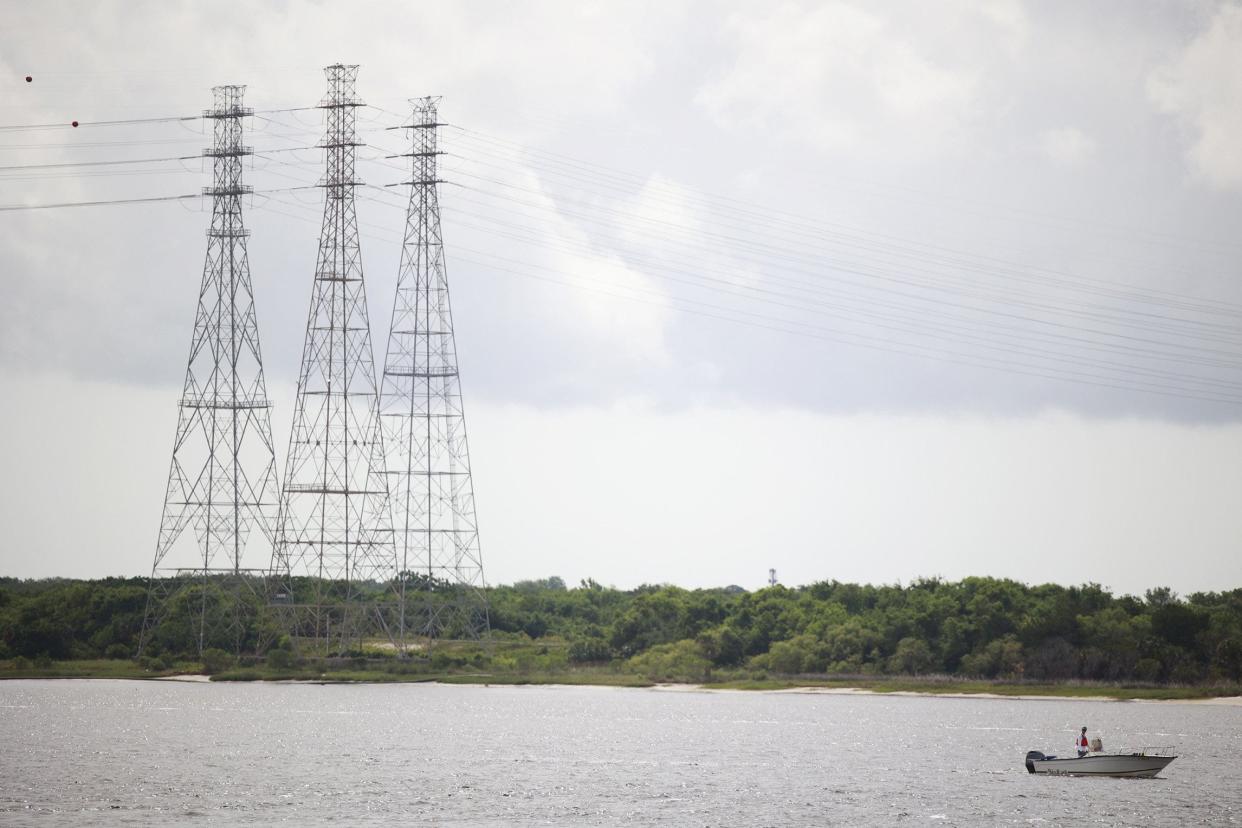JaxPort and JEA line up plan to raise power lines so mega-ships have more clearance

JaxPort and JEA have aligned on a plan for raising power lines spanning the St. Johns River by 2026 so the high-voltage cables won't pose an aerial obstacle to mega-sized cargo ships coming to Jacksonville.
JaxPort and JEA officials have been in sometimes bumpy talks for a few years about the power lines. Earlier this year, a JaxPort board member contended "foot-dragging" JEA administrators have no interest in raising them.
JEA has said it was fulfilling all its commitments by first completing a feasibility study for the project.
The JaxPort board on Monday unanimously approved a memorandum of understanding that the port authority will be responsible for securing the estimated $42 million needed for installing new towers that will hold up the raised transmission lines.
More on the powerlines: JaxPort board member wants binding opinion on whether JEA must raise power lines
The port grows: Jacksonville's port joins Savannah and Miami in deep-water club for Asian cargo
More: Power lines and power plays in Jacksonville's quest to attract biggest cargo ships
JEA, which owns the power lines that deliver electricity to about half its customers, will handle the construction, according to the memorandum.
JaxPort CEO Eric Green said the agreement signals a move toward building a partnership with the utility.
“We’re no longer thinking about it," he said. "We’re signing on the dotted line and moving forward.”
JEA CEO Jay Stowe said Monday he is "pleased that we are moving forward" with JaxPort on plans for raising the lines in a "safe, responsible and economically fair way."
"JEA is focused on how to best serve the growing needs of Northeast Florida and help drive economic growth in the region," he said in a statement. "This project will allow for larger ships and thus provide for more jobs and economic growth in Northeast Florida."
The project marks a continuation of the utility's involvement in economic development projects such as its investment in converting a former Navy base on the Westside into Cecil Commerce Center.
In the case of the power lines, JEA has said money from its customers should not pay for the project. The memorandum of understanding says JaxPort will be responsible for 100% of the cost.
The memorandum is “just a first step,” Nick Primrose, chief of regulatory compliance for JaxPort, told the board.
The next action will be a detailed interlocal agreement. The JEA board will weigh in at that point with a vote on an agreement.
Green said JaxPort has been in talks with various agencies and could have an announcement on its funding partners in the next 60 days.
JaxPort and the U.S. Army Corps of Engineers marked the completion last month of deepening the St. Johns River to 47 feet for cargo ships all the way to the Blount Island terminal, just east of the Dames Point bridge.
The Corps and JaxPort said during the extensive study of deepening the river that no aerial structures, such as the power lines or the Dames Point bridge, would conflict with the passage of the bigger ships coming to Jacksonville with deeper water. But the Corps and JaxPort say that since doing that study, the size of ocean-crossing ships has greatly increased.
Ships going to Blount Island don't have to go under the bridge, but they do sail beneath the power lines that cross the river at a height of 175 feet east of Blount Island.
The schedule for the project will start this year with JEA obtaining engineering service and doing site investigation for an estimated cost of $350,000.
JEA will do project design and permitting for $750,000 in 2023. JaxPort will have to deliver the bulk of the funding in 2024-26 when JEA constructs and install the new towers and conductors.
Trailer Bridge inks lease extension to 2041
In other business at the JaxPort board meeting, the board renewed a lease with long-time tenant Trailer Bridge to keep using Blount Island for its Puerto Rico shipping operations through January 2041.
Trailer Bridge will use nearly 34 acres of Blount Island. Trailer Bridge, Crowley and TOTE form the core of Jacksonville's status as the main hub for shipping between the mainland and Puerto Rico.
"This is a big deal for Trailer Bridge," said Mitch Luciano, CEO of the company headquartered in Jacksonville. "It really sets us up to make the investments we need to make in the Puerto Rican trade because we know we have a long-term lease.”
JaxPort and Trailer Bridge were joined by Joel Piza-Batiz, the executive director of the Puerto Rico Ports Authority, for the lease-signing ceremony. The company's lease in Jacksonville will run for the same length as its lease at the port in San Juan, Puerto Rico.
Trailer Bridge and other shippers serving Puerto Rico and the Caribbean operate ships that do not need the deeper water or higher power lines. The Puerto Rico connection is the "bread and butter" for the port, said Robert Peek, chief commercial officer for JaxPort.
He said the ships carrying Asian trade offer the biggest potential for growth, and those do need the deeper water and raised power lines.
"We want to grow globally," Peek said.
This article originally appeared on Florida Times-Union: JEA and JaxPort plan to raise power lines to allow bigger cargo ships

